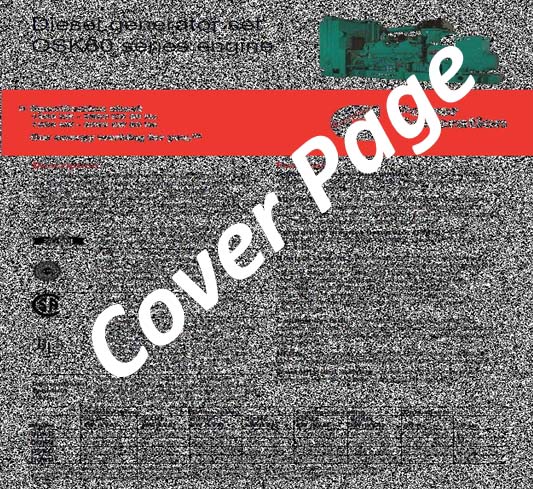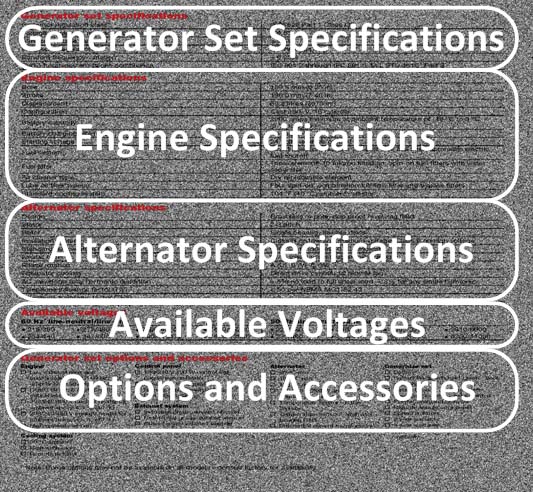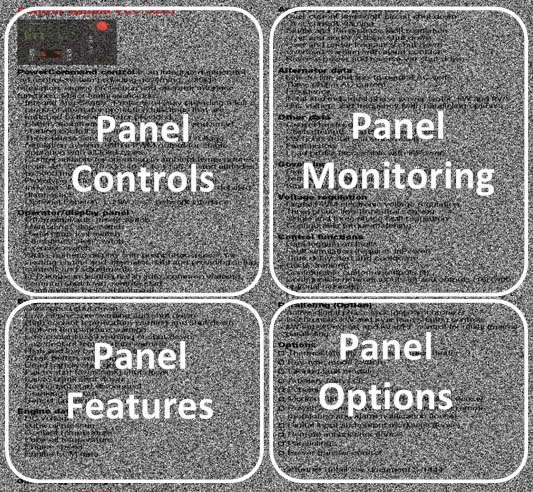Generator Spec Sheets
Each manufacturer creates specification and data sheets for their generators. Understanding these specifications sheets is imperative when selecting a generator for your application.
There are three duty cycles the generators are divided into:
- Standby - Supplies power to a varying electrical load for duration of power interruption.
- Prime - These generators are used in applications that do not have access from a public utility. Prime power generators are divided into the following running times:
- Indefinite Running Time - Maximum power (from a variable load generator set) accessible for an unlimited number of hours per year. The following operational guidelines apply:
- When unit is operated in time slots of 250 hours the unit should be operated at 70% rated performance.
- If generator set must be used at 100% capability, it should not be operated over 500 hours per year. The generator should not be overloaded.
- Limited Running Time - Load is accessible for a limited number of hours in non-variable load applications. Generators can operate up to 750 hours per year less than prime power rating.
- Continuous - Generator sets are used at 100% power rating for an unlimited number of hours per year. They are often used in mining, agriculture and military applications.
When comparing specification sheets between manufacturer's, it is quickly apparent that each manufacturer differs between formatting and content. Basic information is available in each instance. If desired information for the generator set is not in the specification sheet, the manufacturer can be contacted.
The ability to understand a manufacturer's specification sheet and knowing the application, supplies the customer the data needed to make an informed decision.
This article will explore the Cummins generator specification sheets.
Cummins Specification Sheets
We are selecting model DQKC to explore. The specification sheet is divided into the following four pages:
- Description, Features and Ratings - Provides description, features and ratings information.
- Specifications and Options - Supplies generator, engine and alternator specifications. Add on options are also located on this page.
- Control System Capability - Defines protection and monitoring points and additional add on options.
Each page will be divided into groups and each group individually translated. This should supply a firm understanding of the Cummins generator specifications.
Description, Features and Ratings
This page is used as the introduction page to the generator set. Divided into three individual areas:
Description
Series of commercial generator sets are fully integrated (complete set contained on a skid). Can be used in standby, prime or continuous power applications. Generator certifications:
- Certified ISO 9001 and manufactured in facilities certified ISO 9001 or ISO 9002.
- Prototype Test Support (PTS). This verifies performance integrity of generator set design.
- CSA certified. This is for all low voltage models Cummins manufacturers.
- Underwriters Laboratories (UL) certified. UL has tested these generators for stationary generator assemblies, for rated operation.
- International Building Code - Generators are certified for seismic application in accordance with international building codes.
Features
This section outlines the common features included in all generator set models covered in this data sheet. There are no extra charges for features listed below:
- Cummins Heavy Duty Engine - All models have QSK60 4 cycle industrial engines that have low emissions and fast response times to load changes.
- Alternator - When purchasing new, more than one alternator (generator end) size is available. The alternators 2/3 windings produce little third harmonics current.
- Permanent Magnet Generator (PMG) - Using a permanent magnet set up enhances motor starting and fault clearing short circuit capability.
- Control System - Power Command Control (PCC) system is used to control engine and generator functions. Features complete monitoring capabilities.
- Cooling System - Standard integral set radiator system designed, tested and rated at ambient temperatures.
- NFPA - Accepts 100% load in a single step. This means the generator does not have to be loaded in gradual increments.
Ratings
Each generator set model number has been manufactured under a specific application rating. Cummins uses Standby, Prime and Continuous ratings.
The below table is created to the Cummins Specification sheet for a more detailed explanation.
| Rating Application Table |
| Model |
Standby Rating |
Prime Rating |
Continuous Rating |
Data Sheets |
|
60 Hz
kW (kVA)
|
50 Hz
kW (kVA)
|
60 Hz
kW (kVA)
|
50 Hz
kW (kVA)
|
60 Hz
kW (kVA)
|
|
60 Hz |
50 Hz |
| DQKB |
1750 (2188) |
1500 (1875) |
1600 (2000) |
1350 (1688) |
1450 (1813) |
1200 (1500) |
D-3220/3224 |
D-3221 |
| DQKC |
2000 (2500) |
1650 (2063) |
1825 (2281) |
1500 (1875) |
1600 (2000) |
1200 (1500) |
D-3222/3225 |
D-3223 |
| DQKD |
Not Rated |
1800 (2250) |
Not Rated |
1600 (2000) |
Not Rated |
1320 (1650) |
Not Rated |
D-3250 |
| DQKH |
2250 (2813) |
2000 (2500) |
Not Rated |
Not Rated |
Not Rated |
Not Rated |
D-3235 |
D-3236 |
The table is divided into three rating columns (Standby, Prime and Continuous). Each of the rating columns is divided into 60 Hz and 50 Hz columns. The cells below them contain the generator set power rating. Select Model of the generator set and follow to the right of the table for rated power information.
Example:
Model DQKC is the generator set selected. This model is rated for the applications below:
- Standby - Generator can supply 2000 kW, 60 Hz power to varying load while power is interrupted.
- Prime - Generator can supply 1825 kW, 60 Hz power running 8 hours per day.
- Continuous - Generator can supply 1600 kW, 60 Hz power 24 hours per day, 7 days a week.
The table above illustrates that when generator run time increase, the load should decrease. This allows for a long generator life when running under any rating application.
Specifications and Options

The second page of the data sheet is dedicated to the following specifications, options and accessories:
Generator Set Specifications
Basic generator specifications to include:
- Governor regulation class - The governor regulates engine speed (ISO8528 Part 1 Class G3) standard.
- Voltage regulator - Allows voltage to be constant (0.5%) from no load to full load situations.
- Random voltage variations - Fluctuations in magnitude of supply voltage, (0.5%) normal operation.
- Random frequency variations - The amount of frequency change (0.25%) during normal operation.
- Radio frequency emissions - Created during generation because of electromagnetic properties. Complies with both military and IEC standards.
Engine Specifications
Manufacturing specifications for the build of the engine to include:
- Bore - The diameter of the cylinder (6.25 in).
- Stroke - The distance piston travels in cylinder (7.48 in).
- Displacement - The volume of all cylinders in the engine (3673 cubic inches).
- Configuration - Engine block design. (cast iron V16).
- Battery Capacity - The advised amperage of battery (2200 amps @ 0 to 32 degrees F).
- Battery Charging Alternator - Engine alternator charging capacity (40 amps).
- Starting Voltage - Battery voltage needed for engine operation (24 VDC, negative ground).
- Fuel System - Type of fuel system. (Direct injection, #2 diesel fuel, with fuel filter and automatic shutoff).
- Fuel Filter - Type of fuel filter, capability and option (Triple element 10 micron, spin on with water separator).
- Air Cleaner - Style of air cleaners used on engine (dry replaceable element).
- Oil Filter - Engine oil filter amount and style (4 spin on oil filters, combination of full flow and bypass).
- Cooling System - Standard cooling system (can operate at ambient temperatures of 104 degrees F).
Alternator Specifications
Often referred to as generator end. Manufacturing specifications for build to include:
- Design - Describes design of alternator (Brushless, 4-pole, revolving field).
- Stator - Winding pitch is parameter in design (2/3 pitch recommended for all 4-wire applications).
- Rotor - When alternator rotor is attached to an engine, only one bearing is used (single bearing, flexible discs).
- Insulation System - Class of insulation used on windings (class F on High voltage and class H on low voltage). Temperature ratings from 239 to 302 degrees F.
- Standard Temperature Rise - IEC tests generator for standard temperate rise (@104 degrees F ambient temperature, 302 degrees F).
- Exciter Type - Type of magnet used. Two styles permanent and electromagnetic (permanent magnetic generator).
- Phase Rotation - Supplies phase information of generator (A leading B leading C in a clockwise rotation).
- Alternator Cooling - How alternator is cooled during operation (direct drive centrifugal blower fan).
- Harmonic Distortion - Sine wave distortion during linear and non-linear operations (less than 5% no load to full linear load, less than 3% for single harmonic load).
- Telephone Influence Factor (TIF) - Measure of interference of power-line harmonics with telephone lines (less than 50 per NEMA guidelines).
- Telephone Harmonic Factor (THF) - Harmonic distortion caused by generator to analog telephone system. Replaced by Harmonic distortion (less than 3).
Available Voltages
Generators can be connected in two separate methods. Line to line connections are between any two conductors. Line to neutral is between a conductor and neutral.
- 60 Hz line to neutral voltages are:
- 219, 254, 277, 347, 2400, 7200, 7620 or 7970.
- 60 Hz line to line voltages are:
- 380, 440, 480, 600, 4160, 12470, 13200 or 13800.
Generator Set Options and Accessories
Available additions to standard generator set. Divided by the following systems:
- Engine - Low emissions system for model DQKB, NOx for model DQKC, coolant heaters of various voltages for above and below 40 degrees F and high capacity oil pan.
- Cooling System - 122 degree ambient operating temperature system, heat exchanger and remote radiator.
- Control Panel - Anti condensation heater, paralleling configuration ability, remote fault signal package and run relay package.
- Exhaust System - Industrial, residential and critical grade silencers available.
- Alternator - Various temperature rise upgrades, anti condensation heater, temperature sensor upgrades and differential current transformers.
- Generator Set - Battery, battery racks, circuit breakers, disconnect switch, PCC network software, remote annunciator panels, spring isolators and warranty upgrades.
Control System Capabilities

The control system is responsible for controlling all engine and generator functions. The Power Command Control (PCC 3201) system has many monitoring and control functions as illustrated below:
Panel Controls
The PCC control system is an integrated generator set controller that provides governing, voltage regulation, and engine protection. Panel controls are:
- Off/Manual/ Auto selector switch - Selects mode of operation.
- Manual Run/Stop Switch - Press switch when mode switch is in manual to start engine.
- Panel Lamp Test Switch - Press switch to test panel lamps.
- Emergency Stop Switch - Press switch to stop engine. The switch must be pulled out after emergency stop is initiated.
- Exercise Switch - Used to complete pre-programmed exercise sequence when mode switch is in Auto.
- Configuration - Alpha-Numeric display with common LED indicating lamps. Various language capable.
Panel Features
Control panel features engine protection and monitoring listed below:
- Overspeed Shutdown - Panel shuts engine down if it exceeds pre-set limit.
- Low Oil Pressure - Low oil pressure alarm and engine shutdown when oil pressure falls below set points.
- High Coolant Temperature - High coolant temperature alarm and engine shutdown when coolant temperature exceeds setpoints.
- Low Coolant Level - Warning when coolant level falls below sensor. Possible engine shutdown.
- High and Low Battery Voltage - Warning when battery exceeds or falls below setpoints.
- Weak Battery - Warning when battery charge level falls below setpoint.
- Dead Battery - Engine shutdown when battery fails.
- Fail to Start - Overcrank shutdown when engine does not start in a set time.
- Fail to Crank - Engine shutdown because starter does not rotate engine crankshaft.
- Redundant Start Disconnect - Activated with too many start attempts.
- Cranking Lockout - Prevents engine from cranking.
- Sensor Failure - Indicate when a sensor has failed.
Panel Monitoring
The control panel also monitors and controls:
- AmpSentry AC Protection - Monitors over current and short-circuits. Provides single and three fault regulation. Over and under voltage and frequency monitoring and shutdown.
- Alternator Data - Monitors voltage (line to line or line to neutral capable). Monitors current and frequency on all three phases. kW and kVA monitoring.
- Other Data - Provide generator set model, start attempts, starts, running hours, kW hours and fault history.
- Governing - System contains a digital isochronous governor that feature temperature dynamic governing and a smart idle speed control.
- Voltage Regulation - PWM (digital) electronic voltage regulation with three phase line to neutral sensing. Single and three phase fault monitoring and regulation.
- Control Functions - Fault data logger with fault simulation with Inpower software. Time delayed start and cool down controlled. Configurable inputs and outputs with remote emergency stop capability.
Panel Options
Options for the control panel enable greater capabilities. These options include:
- Paralleling options with load sharing controls.
- Thermostatically controls for space heater.
- Key operated mode switch for security.
- External components such as ground fault modules and auxiliary relays for added control.
- Various interface software such as LONWORKS and iWatch
- Additional input and output modules.
- Remote annunciator for alarm monitoring in location other than generator room.
Always consult the owners manual for switch capability and operations. While these sheets contain quite a bit of useful material, it is always good to reference the manufacturer of your unit, or contact the knowledgeable staff here at Generator Source for additional for clarification on your specific generator.
>>Back to Articles & Info<<